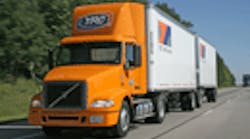Though YRC Worldwide secured enough participation in its debt-for-equity exchange last week to postpone a $19 million interest and fee payment as well as to secure a lifeline of sorts via a $159.8 million line of credit, its struggles – and those of the LTL industry as a whole – are far from over. (More LTL news)
“National carriers like YRC have too much cost, both fixed and variable, built into their infrastructure,” Doug Sartain, president of Cleveland, OH-based Shipmate Logistics, whose trucking career included stints at Pitt Ohio Express, Ward Trucking and Jevic Transportation, told FleetOwner..
“Both P&D and linehaul route shipment density is extremely important to increasing bottom line profits in the LTL industry,” Sartain said. “National LTL carriers are being negatively affected by a decreased market share more so than regional LTL carriers because they have a larger number of terminals spread out across the country, with some in rural areas far away from the core of their business.
“Freight rates have been slashed so much that to cut fixed and variable expenses as a percent of revenue, carriers must fill each trailer full to capacity per trip with revenue-paying shipments,” Sartain added. “ Yet the more terminals a carrier has, the harder it is to fill every trailer to capacity on every trip.”
As an example of this challenge, Sartain compared the shipment volumes of regional carrier Pitt Ohio alongside YRC. “Pitt Ohio handles 9,000 shipments per day through a 21 terminal network, whereas YRC handles about 80,000 shipments through a 430 terminal network,” he noted. “But do the math: it means Pitt Ohio is handling 428 shipments per terminal compared to 186 per terminal for YRC – thus they are operating with far more efficiency, revenue and profit per terminal than YRC is, and at far lower cost.”
Equipment capacity is another major factor, with YRC operating some 15,000 trucks and 61,000 trailers – roughly a 4-to-1 ratio of trailers to trucks – compared to Pitt Ohio’s fleet of 1,000 trucks and 1,600 trailers, resulting in a far less costly 1.2-to-1 trailer to truck ratio.
That lower cost structure is now much more crucial as 70% of LTL freight moves within a 550-mile radius today, said Sartain. “Shippers and manufacturers are now bringing their suppliers and distribution centers closer to drastically reduce logistics costs,” he said. “Such a strategy intrinsically favors the regional model over the national one.”
That being said, all is not lost for YRC in Sartain’s opinion. “Their biggest problems right now are cash flow, that they are under-capitalized, and highly debt-leveraged – that’s a downward spiral that causes many trucking companies to close,” he said. “They need to take a hard look at their model and start closing less profitable terminals in rural locations, then interline with local cartage companies to provide service to those areas. If they cut P&D and linehaul routes by 10%, with corresponding reductions in equipment and personnel, it could make them profitable. If that gets their cost per mile down to where it needs to be.”
Richard Clepper, president of Lancaster, PA-based Clepper Consulting Group who spent 33 years with Yellow Freight before it merged with Roadway to become YRC, noted that the company still has plenty of talented, experienced people on hand for a successful turnaround.
“They’ve really done all they can do in terms of cutting costs in my opinion – they are down to the bare bones,” he told FleetOwner. “What they need to do now is get some meat back on their bones – to go out and get customers excited about the services they provide and thus build up revenues. You can’t cut yourself back to prosperity –you’ve got to get revenue back. But if anyone can do it, they can; they’ve got the people on hand to do it.”




